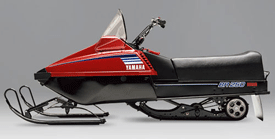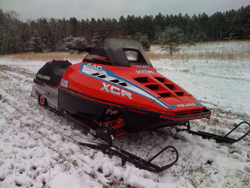 Fifty years ago, snowmobiling was in its infancy – early versions of trail systems were being initiated, numerous companies that were building snowmobiles were starting to blossom and snowmobile racing was off to a vigorous start. There was a lot of trial and error, as designers tried to define a sport that was suddenly becoming all the rage across the Snowbelt.
Fifty years ago, snowmobiling was in its infancy – early versions of trail systems were being initiated, numerous companies that were building snowmobiles were starting to blossom and snowmobile racing was off to a vigorous start. There was a lot of trial and error, as designers tried to define a sport that was suddenly becoming all the rage across the Snowbelt.
In this setting, Snow Goer magazine was born – the brainchild of Joyce “Susie” Scholwin and her husband, Ed. They didn’t know much about magazines, but they had a strong passion for snowmobiling, and that made them want to be a part of the industry.
It is a similar passion – shared by designers, engineers, makers of performance parts and accessories, club volunteers, groomer operators, trail riders, mountain riders, magazine editors and many more – that has driven the sport of snowmobiling for the past 50 years. Paging through the 247 previously printed issues of Snow Goer magazine is a colorful walk through time, the pages decorated by innovative (and sometimes oddball) machines, interesting (and occasionally questionable) aftermarket products and riding gear, and fascinating (and at times dubious) rides.
In its October 2016 issue, Snow Goer invited readers to relive those memories with them. The magazine issue went volume-by-volume through the history of recreational snowmobiling, as reflected in the pages of Snow Goer. Here on snowgoer.com, we’ll take readers on the same journey. You won’t see a lot about racing from the bygone days because that’s never been Snow Goer’s primary role. Instead, you’ll see a lot of history on the machines, classic advertisements, the riding and the passion behind it all. The sections are organized by publishing year – so, for example, the 1970-71 season will start with the fall issues of 1970, which cover the 1971 snowmobile models that were released to the media for testing the previous spring.
We’ll start, though, with an interview that helps explain the magazine’s founding in 1966. Then watch snowgoer.com for the rest of the series, as we take you through the history of snowmobiling. After reading this lead, click through to read the 1966-67 section, the 1967-68 section, the 1968-69 section and the 1969-70 section.
IN THE BEGINNING…
Snow Goer magazine was started by snowmobile enthusiasts Ed and Joyce “Susie” Scholwin in 1966. Both have moved on to the snowmobile trails in the clouds, but their nephew Bill Scholwin – an early investor in the company and the magazine’s first circulation manager – shared some memories during an interview from his Texas home.

SNOW GOER: How and why did the Scholwins start Snow Goer?
BILL SCHOLWIN: They were living in the Northwoods of Wisconsin at the time, up on Butternut Lake near Eagle River, and that was one of the early hearts of snowmobiling. There were no other [snowmobile] publications at the time, other than just club newsletters and such. And, my aunt and uncle naïvely thought that they could go out and sign up advertisers, get advance payments and then use that money to start the magazine. Of course it doesn’t work that way. You have to publish the magazine and then show proof of circulation and then you get paid maybe 30 or 60 days later. They started telling me what they had in mind, and I asked what they thought it would take to get it going [and print the first issue]. They figured $5,000 would do it, and I came up with $5,000. I thought that was supposed to get me half the company, but it ended up getting me one-eighth.
SG: How was the magazine initially received by the public?
SCHOLWIN: It had unbelievable acceptance. There were a whole bunch of people buying snowmobiles and there was nowhere they could read about it. By the time that we sold it [to The Webb Company in 1969], we had over 50,000 paid circulation. I’m told that was a publishing industry record at the time – no enthusiast magazine had ever before grown that rapidly. Our first issue, we printed 50,000 copies and I think national sales was something like 1,200 due to poor placement by the newsstand company, but I think every person who got the magazine passed it to at least two other people, and most of them subscribed to it. It was an unbelievable response.
SG: How was the company structured in those days?
SCHOLWIN: My aunt did most of the writing. My uncle did testing and information about the mechanical and the racing side of things. I filled in wherever I could. Because my background was in computers, I rented some time on a computer and wrote some programs to handle circulation and mailing lists and so on. At the end of the first year, I moved back down to Chicago after living at Butternut Lake for a year, but I stayed involved heavily – I traveled up there a lot and was on the phone with them probably five times a week.
SG: What were your best memories of working for Snow Goer back in the day?
SCHOLWIN: I got to ride all kinds of different brands everywhere you can think of in that area. We lived in the Nicolet National Forest in those days and during that first year they had Job Corps crews out there making trails in the national forest using a lot of the logging roads and logging railroad grade spurs. We used to run those on the snowmobiles. I loved to run a snowmobile at night, as long it was on an established trail or road or something. Nighttime was not the time to go exploring on a snowmobile [due to culverts and fences].
SG: What led the family to sell the business?
SCHOLWIN: We were always short of money, robbing Peter to pay Paul. My aunt was constantly looking to raise money and wanted to have somebody hopefully buy-in without [the family] giving up control. Of course, that wouldn’t happen – she found several people willing to put adequate money into the business, but they wanted control, and we weren’t ready to give that up. I don’t know exactly how she met [representatives from The Webb Company], but somebody acted as an agent [and brokered the deal].
SG: After the sale to Webb, Susie and Ed appeared in a few issues then disappeared from print. What happened?
SCHOLWIN: When they sold out, they got two-year contracts with Webb as editors. That was Webb’s idea – they not only bought the brand, they also brought along the heart of the magazine at the time, which was Susie and Ed Scholwin. Everybody who was into [snowmobiling] knew them, all the racers knew them. Right after they sold to Webb, that first season they had a motorhome that was winterized, and they would show up at Eagle River or Rhinelander, or over to Minnesota and into Michigan and so on. It said “Snow Goer magazine” on the side of the motorhome, and that was their hospitality suite on site. So, everybody knew Snow Goer Suzie and her husband, Ed. My understanding is, under the contract, they had great salaries but they blew it by missing deadlines and then, not so much Susie but my uncle, he was a hothead and he tended to mouth off. I’m sure what happened was they got chewed out for missing deadlines and [Ed] told them to go do something to themselves, and Webb did it to them instead.





Please update this excellent articles. MY2026 will be 60 years of SnoGoer. Congratulations. Keep up the good work.